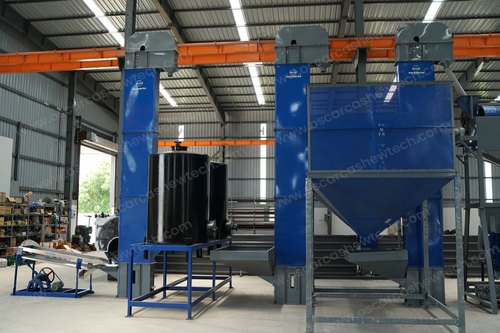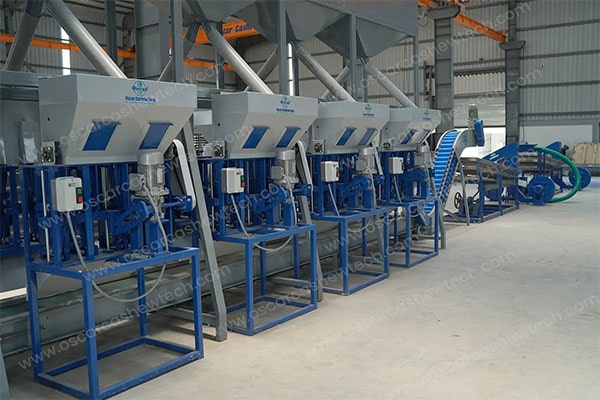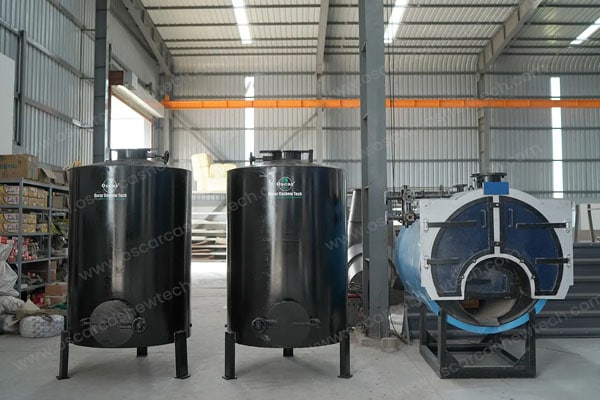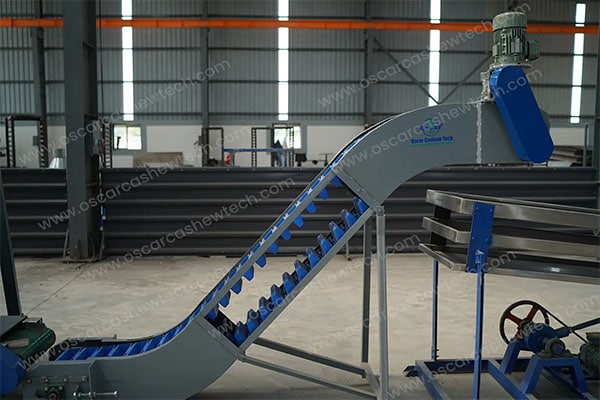Among all processed nuts, cashew nuts are one of the most valuable traded internationally. Still, it takes several steps and high-tech machinery to convert raw cashew nuts into easy-to-eat cashew kernels. Whether you’re beginning anew or enhancing your processing operations, it’s essential to grasp the cashew journey.
This guide explains completely how cashews are processed into kernels and points out the importance of finding a reliable and well-regarded cashew processing machinery in the industry.
Step-1 Collection and Drying of Raw Cashew Nuts
At the start, harvested cashew nuts are taken and allowed to dry.
Cashew nuts are picked from cashew trees and placed in the sun to start drying. Moisture is removed from the nuts in this step to make them ready for further work.
Purpose: Make sure the nuts don’t go bad
Sun drying or hot air dryers are the main technology used.
Step 2: Grading of Raw Cashew Nuts
Nuts are sorted by being graded for their size and overall condition. All sizes make it easier to handle both shelling and cooking jobs. System Used: Cashew Nut Grading Machine Equipment for cashew processing comes from expert cashew machine suppliers.
Step 3 - Steaming or roasting your food
After that, the chefs soften the outside layer of the crab. Most people choose steam cooking because it is both very practical and secure for the kernel. Machine Used: Steam Cooker or Roaster Purpose: Softens the shell so it is more effortless to carry out the removal Made with the help of trusted cashew processing machine manufacturers
Step 4: Removing the shells
They remove the hard exterior to access the kernel found inside. Modern factories count on automatic shelling machines that are automatic to speed up production and cut down on breakages. Machine Used: Automatic Cashew Shelling Machine Advantage: All grains are cut the same and suffer little damage. The machines are suggested by reputable cashew processing manufacturers.
Step 5: Use the Borma Process to Dry
After shelling, moisture in the kernels makes them more likely to develop microorganisms. They are dried for a second time to improve the moisture level and make peeling easier. The cashew kernel dryer (Borma Dryer) was chosen as the main tool. The result is that the overripe fruit has less moisture, so it’s easier to save and peel.
Step 6: peeling
Kernels are often still found with a thin brown outer skin, called a testa. Gently removing the peel is possible with the help of these machines. Cashew peeling is done using the rotary or conveyor cashew peeling machine. Peeling is successful over 95% of the time. Feature: Peeling carried out with air-bladed tools
Step 7: Checking Kernel Grading
Cashew kernels are also classified based on industry guidelines (W180, W240, W320, and so on). By stabilizing the temperature at this point, you improve the product quality for export and in stores. The grading system was carried out using a Kernel Grading Machine. The aim is to use the same categorization for packaging and pricing.
Step 8: Looking at and Packaging the Products
When grading ends, all broken, discolored, or defective cashew kernels are taken out by machine or by people watching carefully. You should pack your meats in bags, preferably vacuum-sealed or flushed with nitrogen. The machines used are called vacuum or nitrogen packaging machines. Results: Produce lasts longer and is packaged for export.
Why Should You Invest in Modern Cashew Processing Technology?
The top cashew processing machine manufacturer makes sure you:
- High processing capability
- A high percentage of kernels that split open
- Working with lower labor and wage prices
- Taking care of food safety regulations
- How well operations can adapt to new levels of demand
- Opportunities and Reasons for Demand
India, Vietnam, and numerous African nations are now major contributors to the cashew processing field. Both the Africa Cashew Splits Week 18 Market Report 2025 and the WCCE Special Edition 2025 point out that the industry needs to become more automated and modern.
Cashew Machine Roadmap can show new investors and processors how to work sustainably and achieve profits when using state-of-the-art processing machines.
Week 18 – 2025 Africa Cashew Splits Market Report – Summary
It has been shown in the Week 18 African cashew splits report that while exports remain stable, the increasing global demand and weather in West Africa cause cashew prices to vary more from week to week.
Key Highlights:
At their peak, harvest season prices for RCN in Ivory Coast and Nigeria averaged $950 to $1,050/MT (cost and freight).
Exports of kernel rose, with more going to India and Vietnam, and nearly all shipments involved White Splits (WS) and Scorched Splits (SS,) taking over 60% of the total volume.
Cashew Processing Problems: Few skilled people were found, and access to automated machines was limited.
Declines in local currencies (including the CFA franc) allowed international buyers to get more affordable RCN prices.
From Asian processors, I observe an increased preference for long-term contract agreements.
Currently, the Market Outlook
Over the next few months, increasing demand from China and Middle East buyers will help balance prices.
It is anticipated that over the long term, greater domestic processing will lead to reduced RCN exports and improved exports of more advanced products.
Cashew Roadmap – Plan for Growth for African & Asian Cashew Producers
The industry depends on a Cashew Roadmap for continued growth and support in countries like Benin, Ghana, Tanzania, India, and Vietnam.
Using Innovative Methods
Growing Municipal Governments
Encourage the building of cashew processing equipment to help the country stop sending out raw cashews.
Create alliances with cashew processing machine manufacturers to receive ready-to-use equipment solutions.
Quality Standardization
Use grading labels by the international kernel classification system (W180, W240, W320, and so on).
Continue providing training on food safety and ISO standards.
Financial Models
The government helps smallholders and cooperatives using microloans and subsidies to buy processing machines.
Encouraging women to run enterprises in the packaging and peeling of cashew.
Export Infrastructure
Clear the way for good facilities for ports, warehousing, and handling cold storage.
Simplify the customs process to promote easier trading.
Technology Transfer
Invite Asian companies in the industry to support African cashew units with knowledge sharing.
Encourage the growth of local assembly and repair divisions.
WCCE Special Edition 2025 – Current Technology Changes in Cashew Processing
The special edition of WCCE 2025 highlights how processing cashews smarter helps increase efficiency, lower damaged kernels, and use energy wisely.
Important trends in the tech industry:
Machines That Grade Using AI
AI has been included in kernel grading machines to regularly make quality assessments and sort products accurately, above 98% of the time.
Units with Sensors as Their Main Feature.
The infrared sensors on new systems allow for more precise pressure, which decreases broken kernels by as much as 40%.
An overview of IoT use in Borma Dryers.
Smart sensors measure temperature and water levels for controlled drying and cost savings of 20%.
Fully Automated Lines are:
End-to-end automation—including grading, steaming, shelling, peeling, and packing—is now available on modular plants designed for any desired throughput (between 200 and 5000 kg per hour).
Sustainable systems for packaging products.
Brands looking to ship goods internationally are using vacuum packing machines with biodegradable films.
Most of these new developments are led by the key manufacturers in India, Vietnam, and Europe.
Steps for Determining LBS (Pounds) of Raw Cashews
Learning how metric units are different from pounds is necessary when you handle raw cashew nuts.
Standard Conversions:
1 Metric Ton (MT) = 1000 kg = 2204.62 pounds (lbs)
1 kg = 2.20462 lbs
Example Calculation:
Just divide 500 kg by 2.2046 and you have the number in pounds.
When we multiply 500 kg by 2.20462, we get 1102.31 lbs/day
Useful Table:
Kilograms are the same as pounds.
Equal to 100 kg is 220.46 lbs
500 kg equals 1102.31 lbs
1000 kg equals 2204.62 lbs
The weight is 2000 kg or 4409.24 lbs.
Application:
Carrying out procurement for the RCN
Figuring out the export weight
Picking the right capacity for the cashew mechanical equipment






